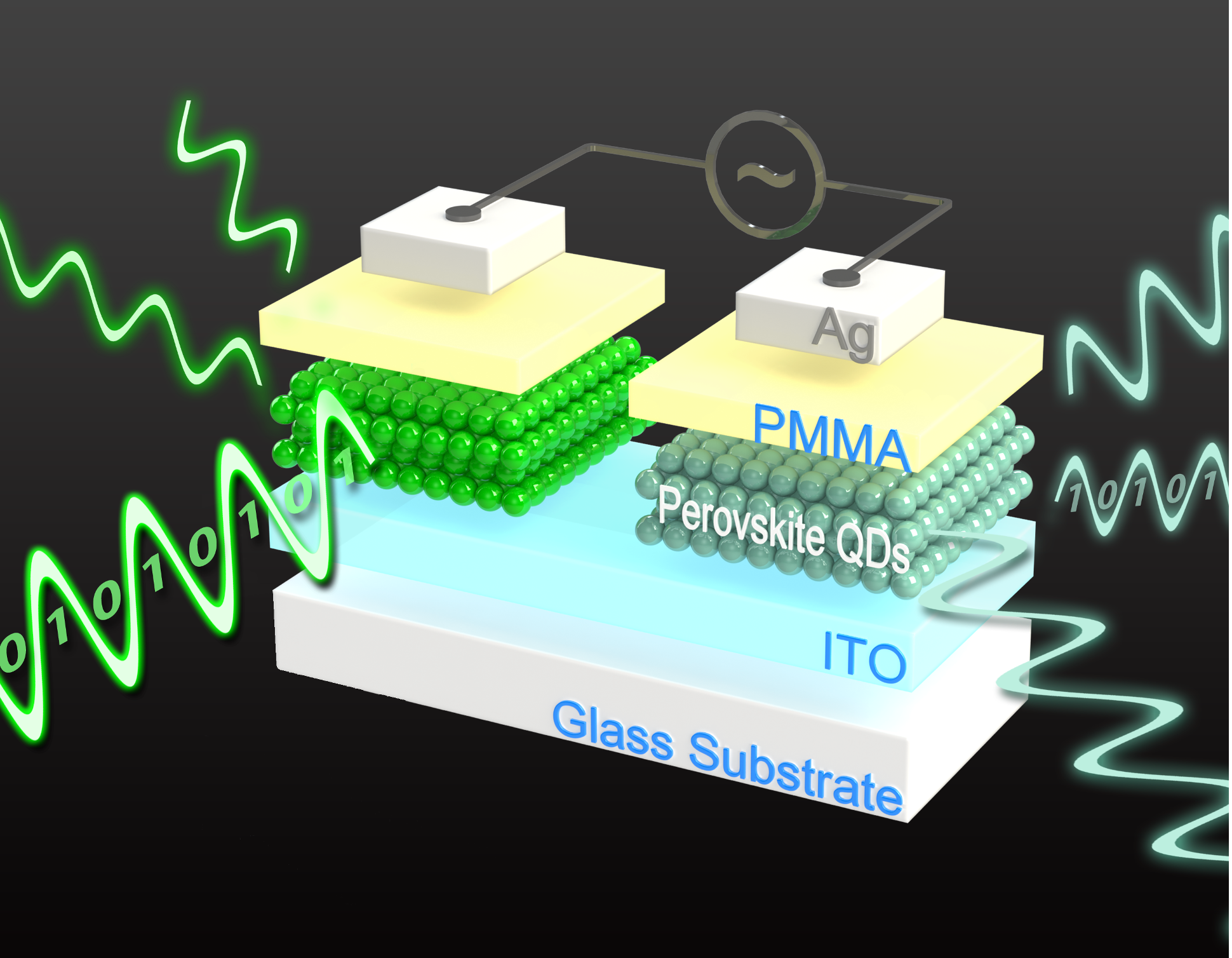Reviewed by Alex SmithAug 24 2021
Researchers from National Taiwan Normal University and Kyushu University have come up with a new device that requires only a single semiconductor called perovskite to concurrently store and visually transmit data.
 An artist’s rendering shows the capability of a CsPbBr3 LEM device for the parallel optical and electrical transmission of encoded information. Two colors can be emitted by the perovskite LEM: green and aqua. These two colors could serve as a real-time indicator of the digital status, i.e., write or erase, of the LEM. Researchers have shown that such seamless integration of photonic emission and electrical resistive switching will open a new horizon for more advanced perovskite optoelectronic technologies. Image Credit: Kyushu University/Ya-Ju Lee.
An artist’s rendering shows the capability of a CsPbBr3 LEM device for the parallel optical and electrical transmission of encoded information. Two colors can be emitted by the perovskite LEM: green and aqua. These two colors could serve as a real-time indicator of the digital status, i.e., write or erase, of the LEM. Researchers have shown that such seamless integration of photonic emission and electrical resistive switching will open a new horizon for more advanced perovskite optoelectronic technologies. Image Credit: Kyushu University/Ya-Ju Lee.
The breakthrough represents a huge leap toward a future of memory devices with higher performance. The researchers integrated a light-emitting electrochemical cell with a resistive random-access memory both based on perovskite, thus achieving parallel and synchronous reading of data both electrically and optically in a “light-emitting memory.”
At the most basic level, digital data is stored as a basic unit of information called a bit, which is usually represented as either a 1 or a 0. Therefore, the search for better data storage boils down to determining highly efficient methods to store and read these zeros and ones.
Flash memory has gained extreme popularity, but scientists have been looking for alternatives that could additionally enhance speed and ease out fabrication.
One such candidate is nonvolatile resistive random-access memory or so-called RRAM. Rather than storing charge in transistors similar to flash memory, resistive memory makes use of materials with the ability to switch between states of high and low resistance to represent zeros and ones.
However, the electrical measurements needed to check the resistance and read zeros and ones from RRAM can limit the overall speed. Recently, to overcome this issue, RRAMs have been combined with LEDs to develop something called light-emitting memories. In this case, the data can also be read by checking if the LED is on or off. This additional optical reading also opens new routes for carrying large amounts of information.
Chun-Chieh Chang, Study Corresponding Author and Professor, National Taiwan Normal University
Yet, earlier versions of light-emitting memories necessitated the integration of two separate devices with differing materials, which complicated the fabrication.
The researchers resolved this issue by turning to perovskite, a kind of material with a crystalline structure through which ions can move to give it exclusive physical, optical and even electrical properties. Perovskite researchers have controlled the ion migration and developed new materials with special properties.
Using just one perovskite layer between contacts, we could fabricate a device that works both as a RRAM and a light-emitting electrochemical cell. By taking advantage of the fast, electrically switchable ionic motion that enables this dual functionality in a single layer of perovskite, we were able to connect two devices together and develop an all-inorganic perovskite light-emitting memory.
Ya-Ju Lee, Study Lead Author, National Taiwan Normal University
The team used perovskite formed of cesium lead bromide (CsPbBr3) and showed that data can be electrically read, written and erased in one of the perovskite devices serving as an RRAM.
At the same time, the second perovskite device has the ability to optically transmit irrespective of whether data is being written or erased via light emission by working as a light-emitting electrochemical cell with a high transmission speed.
Moreover, perovskite quantum dots of two different sizes were utilized by the scientists for the two devices in the light-emitting memory to realize different emission colors based on whether the memory was being written or erased, thus offering a real-time indicator of the zeros and ones.
Kaoru Tamada, a distinguished professor at Kyushu University’s Institute for Materials Chemistry and Engineering, also contributed to the project and looks for several opportunities for this new technology moving forward.
This demonstration significantly broadens the scope of applications of the developed all-perovskite light-emitting memory and can serve as a new paradigm of synergistic combination between electronic and photonic degrees of freedom in perovskite materials. From multicast mesh network to data encryption systems, these findings have the potential for numerous applications in next-generation technologies.
Kaoru Tamada, Distinguished Professor, Institute for Materials Chemistry and Engineering, Kyushu University
Journal Reference:
Yen, M.-C., et al. (2021) All-inorganic perovskite quantum dot light-emitting memories. Nature Communications. doi.org/10.1038/s41467-021-24762-w.